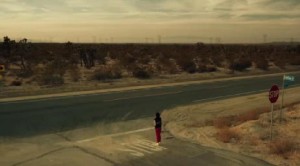MANILA, Philippines—The motion picture itself does not fall short of the eerie and shriek-inducing scenes expected of a horror film. Most encounters were dark enough to indicate the presence of an unwanted visitor and the sound effects were put just in the right space to cause gasps and make eyes close in surprise. But once you sit down to ponder on the story, as in the very substance of what you just watched, you might find yourself asking, “So what really happened?”
The Nicholas McCarthy film “At the Devil’s Door” revolves around three heroines: Hanna White (Ashley Rickards), Leigh (Catalina Sandino Moreno), and Vera (Naya Rivera), with Hanna being the starting point of the conflict. It was in 1987 when the 17-year-old girl started dating a guy she barely knew, and then she was allured to playing this shell game with a random, obviously satanic, man who’d give her $500 after the game.
Hanna, who successfully wins all three guesses in the shell game, was given the money and then she was instructed to go somewhere isolated. There, she was to whisper her name so “he” would know that she is the “chosen one.” Though trembling in fear, Hanna still followed every instruction given to her, and then later on, she suffered the consequences of her actions.
Jumping to the present, the film immediately introduced two new heroines, sisters Leigh and Vera. Leigh was a real estate agent while Vera—an artist who refuses to be in a committed relationship.
These two had nothing to do with the pact that Hanna made when she played the shell game. But for some reasons, they ended up experiencing the worst outcome of the young girl’s experimental act.
In truth, if not for Bridger Nielson’s gorgeous cinematography and Bill Neil and Jake York’s solid sense of editing, the film would have been nothing more than a black and white screenplay with a stereotypical take on girls with extra dark eyeliners, and a complete disregard on people who arrived within the vicinity before Leigh and Vera did.
Whose door are you standing at?
If taken literally, the movie tells the unfortunate account of three heroines who never stood a chance against a force so dark and powerful as the evil element in the story.
But if scrutinized beyond what it offers, we will realize that we all have a devil’s door where we once stood at—if we’re not currently still standing there. In reality, we don’t go to random people to play shell games and sell souls, but we do face temptation every single day because it always comes to us.
Once it calls—“Come to me”—how strong are we to resist it? We have the freedom to choose whether we’ll turn the door’s knob or not, whether we’ll cross the door or we’ll stay away from it. But in Hanna’s case, she did. She opened the door, crossed it, and succumbed to the force without a fighting chance.
Leigh on the other hand didn’t have any idea what she was dealing with. She tried facing it head on, but she lost the battle. And Vera, she who was called “dark” and was detached from the norm of this world, fought the longest battle against free will.
In the end, the three heroines were overpowered by the evil force. Perhaps, this is the movie’s way of asking, had you been in their shoes, would you have opened it? Would you have crossed the door? If yes, are you prepared for its consequences?
Think it over.
